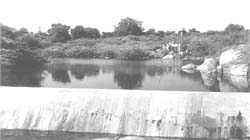Changing colours

fifty years ago, Anantapur district in Andhra Pradesh was covered with dense forests. People were rich and prosperous. All was well till a famine ravaged the district and forced the people to go hungry. Forests became their only source of livelihood. Fifty years later, Anantapur stands bare. Its parched land signifies one of the biggest ecological disasters in the state's history.
"Some sensible people tried to convince others that if they destroy the forests, they will have to face Nature's wrath. But nobody listened to them,' says Dase Goud, 75, a villager from Hottebetta in Anantapur who has played a vital role in the protection of forests since the 1940s.
In most of the 964 villages, there is little water for irrigation and people have to walk several kilometres in search of potable water. The annual rainfall is less than 550 cm, second only to Jaisalmer, which receives the lowest rainfall in India. With 95 per cent of its forests degraded, there are dire predictions that Anantapur may turn into a desert in the near future.
Now the government has initiated watershed development and forest management programmes in the region, and people like Goud have taken the lead in efforts to unite the people in regenerating their lands. Goud is behind the success of the Vana Samrakshana Samithi ( vss ) programme in Hottebetta.
A new beginning Since the 1960s, several state governments have tried to regenerate the forests in Anantapur, but they were not successful. It is only because of the Chandrababu Naidu government's effort that the district is coming back to life, says Suresh Chandra, divisional forest officer (watershed). The government prepared an integrated action plan for the project period (1995-96 to 1998-99) for 247 watersheds in the district. Each watershed is spread over an area of 200 hectares (ha) and received Rs 20 lakh for carrying out the project. Further, the government has identified 2,000 locations in Anantapur where saplings will be planted, says Kallol Biswas, district forest officer, Anantapur.
The state government has also issued orders to provide a 100 per cent share of timber and bamboo to vss members, enhancing it from the 50 per cent share envisaged earlier. People contribute 50 per cent of the total cost either in the form of shramdan (voluntary labour) or money. There are around 95 vss units managing around 22,319 ha of forest area in the district. Most of them have surplus fuel and fodder.
"I can confidently say that farmers in Anantapur can cultivate two crops in a year,' says Naidu. Chiyyedu and P Yaleru villages have already restored the confidence Naidu has in the watershed projects, and have started cultivating two crops every year.
Besides, the people have taken up various development activities such as soil conservation, minor irrigation, afforestation, horticulture and animal husbandry. "Now, there is sufficient water for irrigation and drinking purposes,' says H Reddy, chairperson of P Yaleru watershed committee- b .
"Till 1995, the attempt to revive the forest did not yield any results because of lack of people's participation,' says H Annapurnama, a lady member of Hottebetta vss . But now people are more enthusiastic about the regeneration programmes, because it is also a source of employment for them, adds P Raghuveer, deputy conservator of forests, Andhra Pradesh Forestry Project, Hyderabad.
Watershed programmes in villages like Hottebetta, Chiyyedu and Dasampalli have certainly helped the soil to retain moisture, says B Sreenivas, technical director, Rural Development Trust, Anantapur.
According to Narayan Reddy, chairperson of P Yaleru watershed commitee- a , "We are progressing. But there are still a lot of problems. It would take at least another 200-300 years to regain what the district has lost,' says P Murali Dhardu, professor, department of rural development, S K University, Anantapur. Only 20 per cent of the watershed project has been successful, he says. "Some influential people are taking contracts to develop watersheds. But they have not performed. A whole set of non-governmental organisations are a part of the politician-bureaucrat nexus,' says a government official. "I agree that things are not moving as expected. But all of a sudden I cannot change everybody,' contends Naidu.
Related Content
- Order of the National Green Tribunal regarding illegal mining within the eco-sensitive zone of Son Gharial Wildlife Sanctuary, 05/10/2023
- Order of the National Green Tribunal regarding a salt factory polluting environment in village Dokha Dina, district Charkhi Dadri, Haryana, 21/09/2023
- Report by BBMP on illegal disposal of effluents into the storm water drain, Hemmigepura, Rajarajeshwarinagara zone of Bruhat Bengaluru Mahanagara Palike, Karnataka, 09/06/2021
- The Allahabad High Court order on Ganga pollution, 28/01/2021
- Symbolic representation of numerosity by honeybees (Apis mellifera): matching characters to small quantities
- Empowering women on the frontlines of climate change
